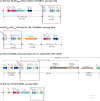DNA microarray profiling of a diverse collection of nosocomial methicillin-resistant staphylococcus aureus isolates assigns the majority to the correct sequence type and staphylococcal cassette chromosome mec (SCCmec) type and results in the subsequent identification and characterization of novel SCCmec-SCCM1 composite islands
- PMID: 22869569
- PMCID: PMC3457404
- DOI: 10.1128/AAC.01247-12
DNA microarray profiling of a diverse collection of nosocomial methicillin-resistant staphylococcus aureus isolates assigns the majority to the correct sequence type and staphylococcal cassette chromosome mec (SCCmec) type and results in the subsequent identification and characterization of novel SCCmec-SCCM1 composite islands
Abstract
One hundred seventy-five isolates representative of methicillin-resistant Staphylococcus aureus (MRSA) clones that predominated in Irish hospitals between 1971 and 2004 and that previously underwent multilocus sequence typing (MLST) and staphylococcal cassette chromosome mec (SCCmec) typing were characterized by spa typing (175 isolates) and DNA microarray profiling (107 isolates). The isolates belonged to 26 sequence type (ST)-SCCmec types and subtypes and 35 spa types. The array assigned all isolates to the correct MLST clonal complex (CC), and 94% (100/107) were assigned an ST, with 98% (98/100) correlating with MLST. The array assigned all isolates to the correct SCCmec type, but subtyping of only some SCCmec elements was possible. Additional SCCmec/SCC genes or DNA sequence variation not detected by SCCmec typing was detected by array profiling, including the SCC-fusidic acid resistance determinant Q6GD50/fusC. Novel SCCmec/SCC composite islands (CIs) were detected among CC8 isolates and comprised SCCmec IIA-IIE, IVE, IVF, or IVg and a ccrAB4-SCC element with 99% DNA sequence identity to SCC(M1) from ST8/t024-MRSA, SCCmec VIII, and SCC-CI in Staphylococcus epidermidis. The array showed that the majority of isolates harbored one or more superantigen (94%; 100/107) and immune evasion cluster (91%; 97/107) genes. Apart from fusidic acid and trimethoprim resistance, the correlation between isolate antimicrobial resistance phenotype and the presence of specific resistance genes was ≥97%. Array profiling allowed high-throughput, accurate assignment of MRSA to CCs/STs and SCCmec types and provided further evidence of the diversity of SCCmec/SCC. In most cases, array profiling can accurately predict the resistance phenotype of an isolate.
Figures


References
-
- Altschul SF, Gish W, Miller W, Myers EW, Lipman DJ. 1990. Basic local alignment search tool. J. Mol. Biol. 215:403–410 - PubMed
-
- Bartels MD, Hansen LH, Boye K, Sorensen SJ, Westh H. 2011. An unexpected location of the arginine catabolic mobile element (ACME) in a USA300-related MRSA strain. PLoS One 6:e16193 doi:10.1371/journal.pone.0016193 - DOI - PMC - PubMed
-
- Carroll D, Kehoe MA, Cavanagh D, Coleman DC. 1995. Novel organization of the site-specific integration and excision recombination functions of the Staphylococcus aureus serotype F virulence-converting phages phi 13 and phi 42. Mol. Microbiol. 16:877–893 - PubMed
-
- Carroll JD, et al. 1989. A new methicillin- and gentamicin-resistant Staphylococcus aureus in Dublin: molecular genetic analysis. J. Med. Microbiol. 28:15–23 - PubMed
-
- Castanheira M, Watters AA, Mendes RE, Farrell DJ, Jones RN. 2010. Occurrence and molecular characterization of fusidic acid resistance mechanisms among Staphylococcus spp. from European countries (2008). J. Antimicrob. Chemother. 65:1353–1358 - PubMed
Publication types
MeSH terms
Substances
LinkOut - more resources
Full Text Sources
Medical
Research Materials

